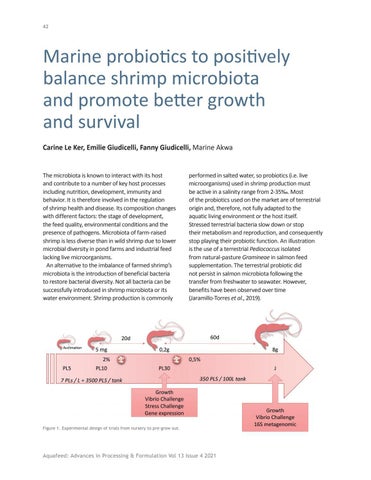42
Marine probiotics to positively balance shrimp microbiota and promote better growth and survival Carine Le Ker, Emilie Giudicelli, Fanny Giudicelli, Marine Akwa
The microbiota is known to interact with its host and contribute to a number of key host processes including nutrition, development, immunity and behavior. It is therefore involved in the regulation of shrimp health and disease. Its composition changes with different factors: the stage of development, the feed quality, environmental conditions and the presence of pathogens. Microbiota of farm-raised shrimp is less diverse than in wild shrimp due to lower microbial diversity in pond farms and industrial feed lacking live microorganisms. An alternative to the imbalance of farmed shrimp’s microbiota is the introduction of beneficial bacteria to restore bacterial diversity. Not all bacteria can be successfully introduced in shrimp microbiota or its water environment. Shrimp production is commonly
performed in salted water, so probiotics (i.e. live microorganisms) used in shrimp production must be active in a salinity range from 2-35‰. Most of the probiotics used on the market are of terrestrial origin and, therefore, not fully adapted to the aquatic living environment or the host itself. Stressed terrestrial bacteria slow down or stop their metabolism and reproduction, and consequently stop playing their probiotic function. An illustration is the use of a terrestrial Pediococcus isolated from natural-pasture Gramineae in salmon feed supplementation. The terrestrial probiotic did not persist in salmon microbiota following the transfer from freshwater to seawater. However, benefits have been observed over time (Jaramillo-Torres et al., 2019).
Figure 1. Experimental design of trials from nursery to pre-grow out.
Aquafeed: Advances in Processing & Formulation Vol 13 Issue 4 2021









